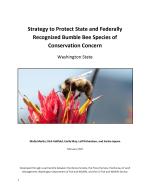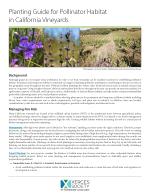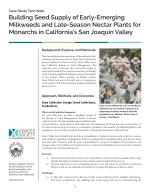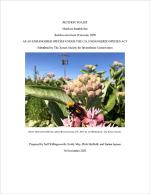As a science-based organization, the Xerces Society produces dozens of publications annually, all of which employ the best available research to guide effective conservation efforts. Our publications range from guidelines for land managers, to brochures offering overviews of key concepts related to invertebrate conservation, from books about supporting pollinators in farmland, to region-specific plant lists. We hope that whatever you are seeking—whether it's guidance on making a home or community garden pollinator-friendly, advice on developing a local pesticide reduction strategy, or detailed information on restoring habitat—you will find it here!
Find Publications
Use the search functions to sort by publication type (books, guidelines, fact sheets, etc.), location, and/or subject (agriculture, gardens, pollinators, pesticides, etc.).
The the loopy five firefly (Photuris forresti) was proposed for listing in 2023 through a petition submitted by the Xerces Society.
The the mysterious lantern firefly (Photuris mysticalampas) was proposed for listing in 2023 through a petition submitted by the Xerces Society. The mysterious lantern firefly, a native species endemic to the Delmarva Peninsula of Delaware and Maryland, is associated with high quality forested peatland floodplain habitats. It is known from only six sites in two watershed. As a habitat specialist, the mysterious lantern firefly is threatened by habitat loss, fragmentation, and degradation.
Our donor newsletter includes news and information about Xerces' programs and conservation work.
In this issue:
- Tiny But Not Trivial: The Indisputable Value of Invertebrates
- Invertebrate Spotlights
- The Power of One, the Impact of Many: Expansion of the Xerces Ambassador Program
- Volunteer
- New Fundraising Tools
- Throw a Party for Invertebrates: Creative Fundraisers Increase Our Conservation Capacity
- Upcoming Events
California
This information sheet has details of the plant species included in the California Monarch and Pollinator Habitat Kits, an overview of the habitat kit project, and guidance on how to request a kit.
(U.S. Fish and Wildlife Service)
Conservation recommendations from the U.S.
Washington State
The objective of this conservation strategy is to identify geographic areas within the state of Washington with the highest potential to support rare and declining bumble bee species and provide guidance and recommendations for management of those areas. Maintaining sufficient populations of each focal species is essential to the long-term persistence of these animals. This will require protecting and enhancing habitat for foraging, nesting, and overwintering, while ensuring connectivity between habitat areas, across jurisdictions.
Although grapes do not require insect pollination in order to set fruit, vineyards can be excellent locations for establishing pollinator habitat. Permanent and temporary habitat in vineyards can support declining pollinator populations contributing to species recovery in key geographic areas throughout the state. Pollinator habitat plantings also attract other beneficial insects such as natural enemies that prey on crop pests.
Developed by the Xerces Society for Invertebrate Conservation, with support from Oregon Tilth and the USDA’s Natural Resources Conservation Service, Bee Better Certified works with farmers and food companies to make places that are better for bees and other pollinators. This brochure serves as an informative introduction to the program.
Bee Better Certified® is the gold standard of pollinator-focused farm certification programs. Developed by the Xerces Society, the world’s largest science-based pollinator conservation organization, Bee Better Certified builds upon nearly two decades of on-farm habitat research and development.
Essays on Invertebrate Conservation
Understanding the natural history of the species we work with is the foundation of our efforts to protect invertebrates and their habitats. We at Xerces are completely enthralled by the amazing behaviors, intriguing relationships, and eye-catching beauty of these animals. This issue of Wings features bees, butterflies and wasps, and dragonflies. We hope you find them as entrancing as we do.












